Abstract
Sleep hypoxaemia in non-rapid eye movement (non-REM) and rapid eye movement (REM) sleep was examined in 20 patients with various neuromuscular disorders with reference to the relation between oxygen desaturation during sleep and daytime lung and respiratory muscle function. All the patients had all night sleep studies performed and maximum inspiratory and expiratory mouth pressures (PI and Pemax), lung volumes, single breath transfer coefficient for carbon monoxide (KCO), and daytime arterial oxygen (PaO2) and carbon dioxide tensions (PaCO2) determined. Vital capacity in the erect and supine posture was measured in 14 patients. Mean (SD) PI max at RV was low at 33 (19) cm H2O (32% predicted). Mean PE max at TLC was also low at 53 (24) cm H2O (28% predicted). Mean daytime PaO2 was 67 (16) mm Hg and PaCO2 52 (13) mm Hg (8.9 (2.1) and 6.9 (1.7) kPa). The mean lowest arterial oxygen saturation (SaO2) was 83% (12%) during non-REM and 60% (23%) during REM sleep. Detailed electromyographic evidence in one patient with poliomyelitis showed that SaO2% during non-REM sleep was maintained by accessory respiratory muscle activity. There was a direct relation between the lowest SaO2 value during REM sleep and vital capacity, daytime PaO2, PaCO2, and percentage fall in vital capacity from the erect to the supine position (an index of diaphragm weakness). The simple measurement of vital capacity in the erect and supine positions and arterial blood gas tensions when the patient is awake provide a useful initial guide to the degree of respiratory failure occurring during sleep in patients with neuromuscular disorders. A sleep study is required to assess the extent of sleep induced respiratory failure accurately.
Full text
PDF
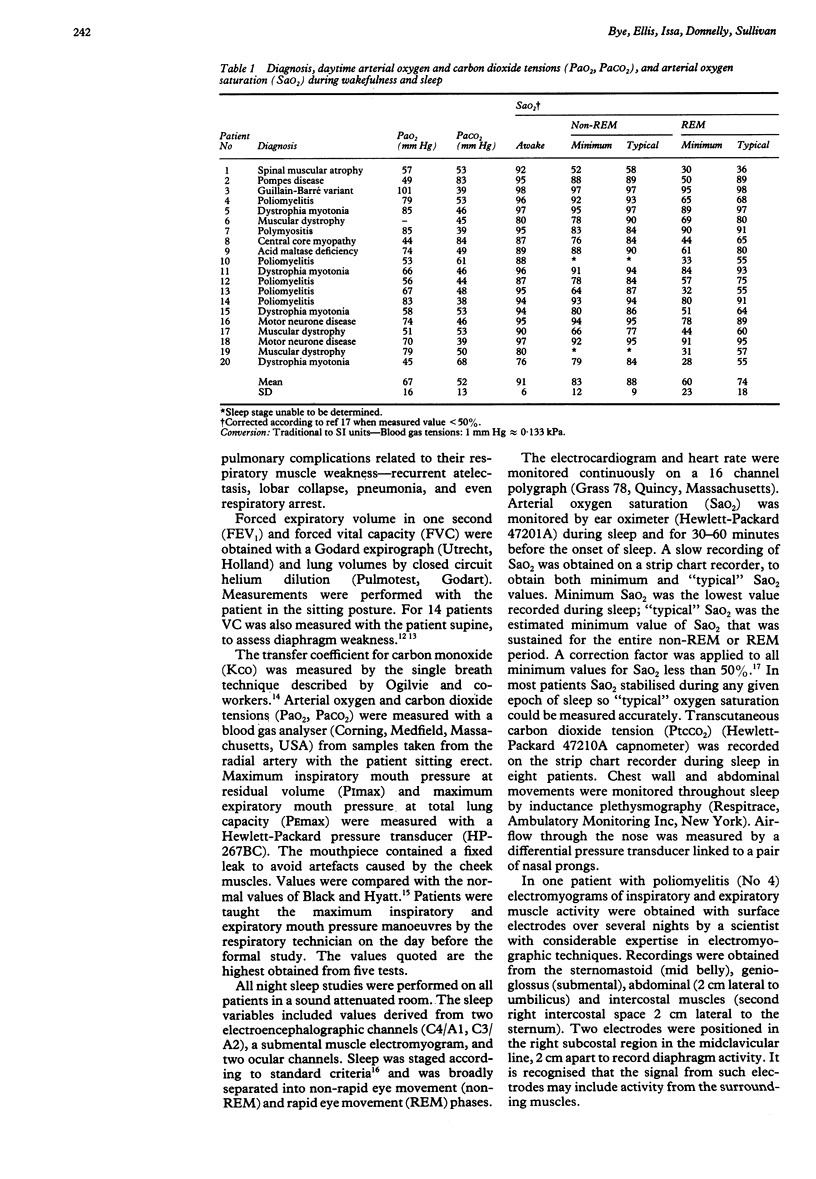

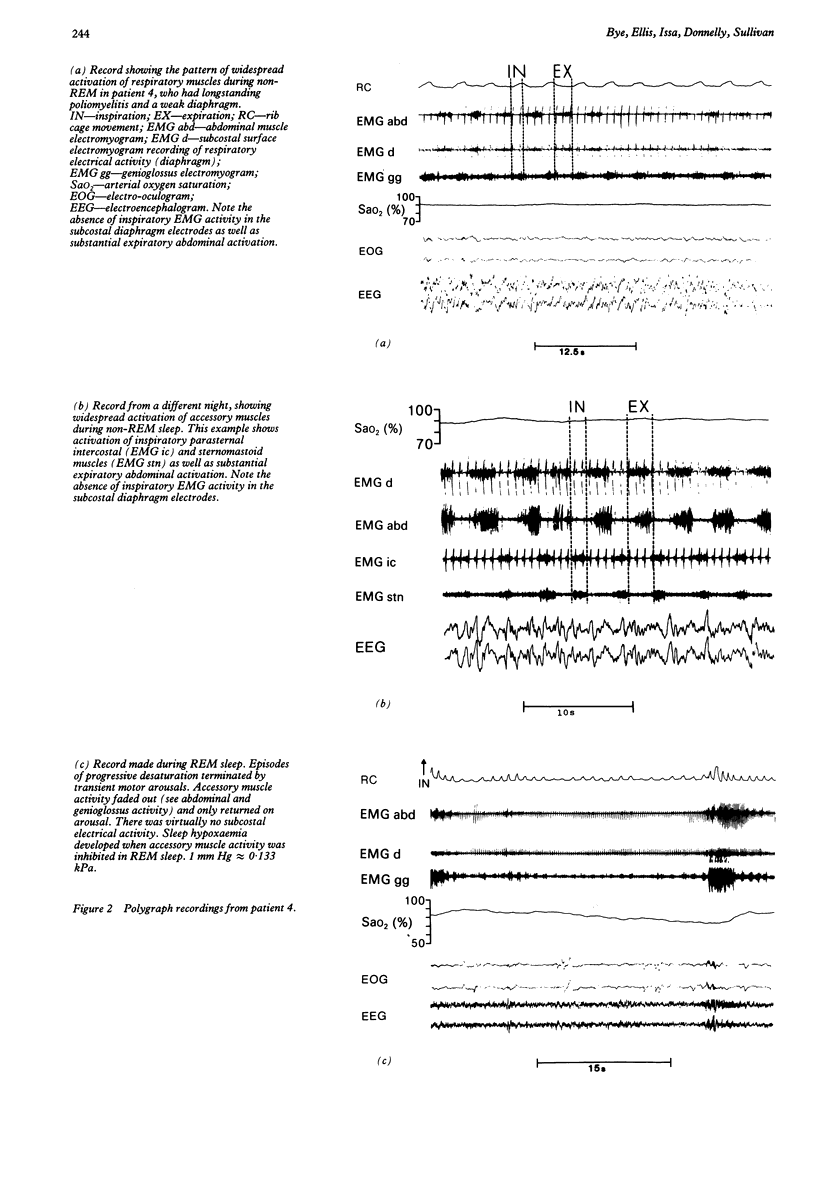
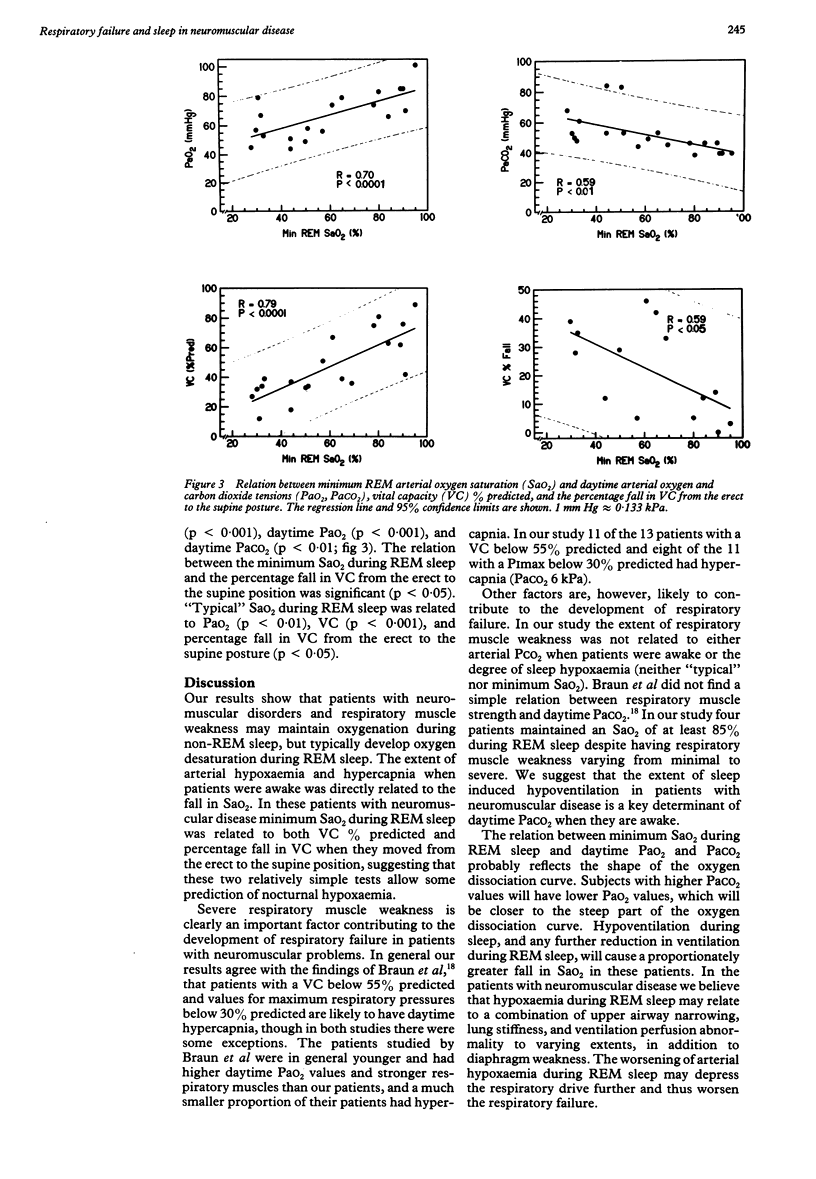
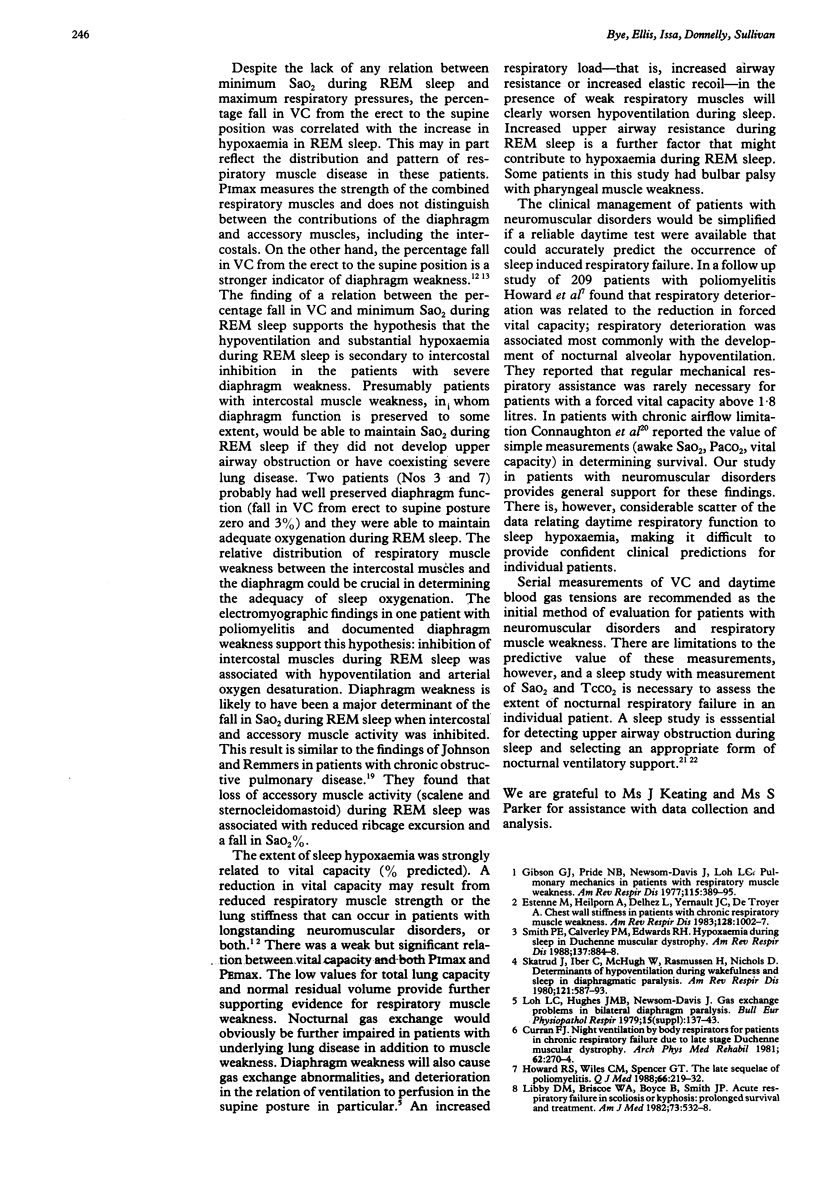
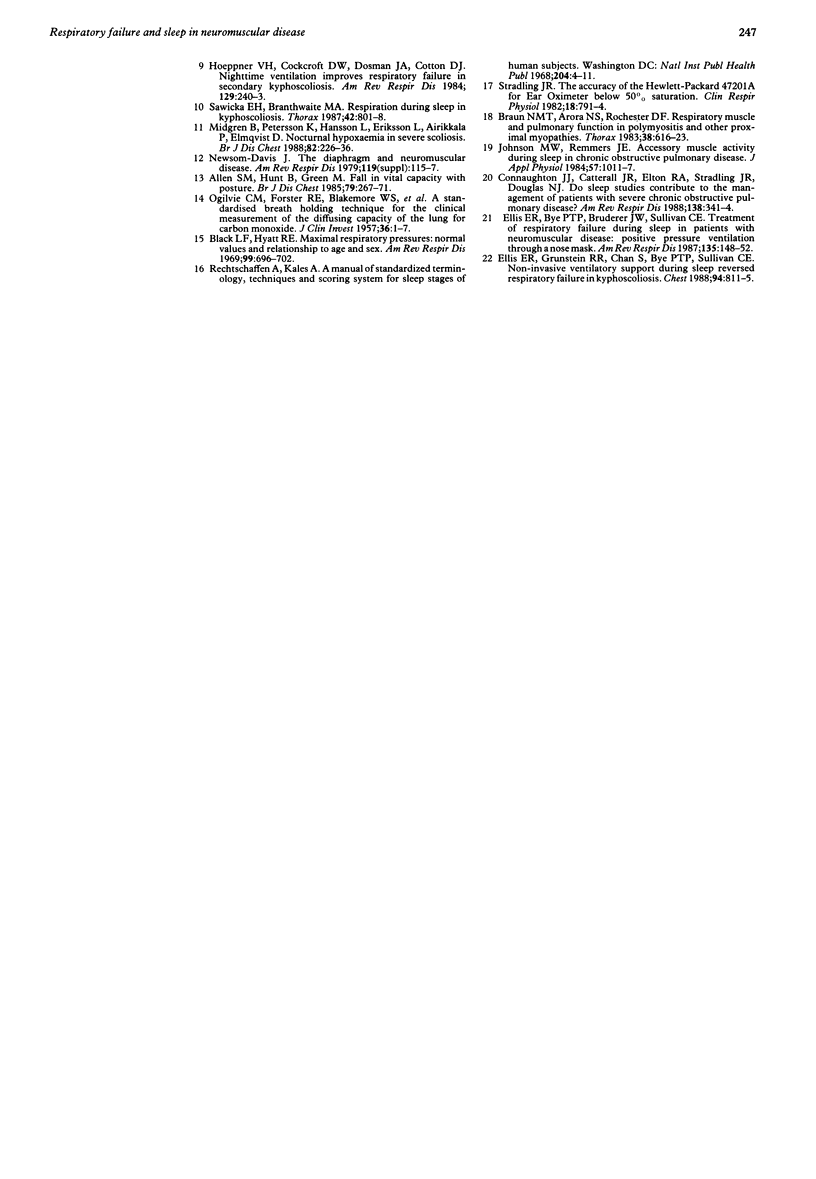
Selected References
These references are in PubMed. This may not be the complete list of references from this article.
- Allen S. M., Hunt B., Green M. Fall in vital capacity with posture. Br J Dis Chest. 1985 Jul;79(3):267–271. [PubMed] [Google Scholar]
- BLAKEMORE W. S., FORSTER R. E., MORTON J. W., OGILVIE C. M. A standardized breath holding technique for the clinical measurement of the diffusing capacity of the lung for carbon monoxide. J Clin Invest. 1957 Jan;36(1 Pt 1):1–17. doi: 10.1172/JCI103402. [DOI] [PMC free article] [PubMed] [Google Scholar]
- Black L. F., Hyatt R. E. Maximal respiratory pressures: normal values and relationship to age and sex. Am Rev Respir Dis. 1969 May;99(5):696–702. doi: 10.1164/arrd.1969.99.5.696. [DOI] [PubMed] [Google Scholar]
- Braun N. M., Arora N. S., Rochester D. F. Respiratory muscle and pulmonary function in polymyositis and other proximal myopathies. Thorax. 1983 Aug;38(8):616–623. doi: 10.1136/thx.38.8.616. [DOI] [PMC free article] [PubMed] [Google Scholar]
- Connaughton J. J., Catterall J. R., Elton R. A., Stradling J. R., Douglas N. J. Do sleep studies contribute to the management of patients with severe chronic obstructive pulmonary disease? Am Rev Respir Dis. 1988 Aug;138(2):341–344. doi: 10.1164/ajrccm/138.2.341. [DOI] [PubMed] [Google Scholar]
- Curran F. J. Night ventilation by body respirators for patients in chronic respiratory failure due to late stage Duchenne muscular dystrophy. Arch Phys Med Rehabil. 1981 Jun;62(6):270–274. [PubMed] [Google Scholar]
- Ellis E. R., Bye P. T., Bruderer J. W., Sullivan C. E. Treatment of respiratory failure during sleep in patients with neuromuscular disease. Positive-pressure ventilation through a nose mask. Am Rev Respir Dis. 1987 Jan;135(1):148–152. doi: 10.1164/arrd.1987.135.1.148. [DOI] [PubMed] [Google Scholar]
- Estenne M., Heilporn A., Delhez L., Yernault J. C., De Troyer A. Chest wall stiffness in patients with chronic respiratory muscle weakness. Am Rev Respir Dis. 1983 Dec;128(6):1002–1007. doi: 10.1164/arrd.1983.128.6.1002. [DOI] [PubMed] [Google Scholar]
- Gibson G. J., Pride N. B., Davis J. N., Loh L. C. Pulmonary mechanics in patients with respiratory muscle weakness. Am Rev Respir Dis. 1977 Mar;115(3):389–395. doi: 10.1164/arrd.1977.115.3.389. [DOI] [PubMed] [Google Scholar]
- Hoeppner V. H., Cockcroft D. W., Dosman J. A., Cotton D. J. Nighttime ventilation improves respiratory failure in secondary kyphoscoliosis. Am Rev Respir Dis. 1984 Feb;129(2):240–243. [PubMed] [Google Scholar]
- Howard R. S., Wiles C. M., Spencer G. T. The late sequelae of poliomyelitis. Q J Med. 1988 Mar;66(251):219–232. [PubMed] [Google Scholar]
- Johnson M. W., Remmers J. E. Accessory muscle activity during sleep in chronic obstructive pulmonary disease. J Appl Physiol Respir Environ Exerc Physiol. 1984 Oct;57(4):1011–1017. doi: 10.1152/jappl.1984.57.4.1011. [DOI] [PubMed] [Google Scholar]
- Libby D. M., Briscoe W. A., Boyce B., Smith J. P. Acute respiratory failure in scoliosis or kyphosis: prolonged survival and treatment. Am J Med. 1982 Oct;73(4):532–538. doi: 10.1016/0002-9343(82)90332-1. [DOI] [PubMed] [Google Scholar]
- Loh L., Hughes J. M., Davis J. N. Gas exchange problems in bilateral diaphragm paralysis. Bull Eur Physiopathol Respir. 1979;15 (Suppl):137–143. [PubMed] [Google Scholar]
- Midgren B., Petersson K., Hansson L., Eriksson L., Airikkala P., Elmqvist D. Nocturnal hypoxaemia in severe scoliosis. Br J Dis Chest. 1988 Jul;82(3):226–236. doi: 10.1016/0007-0971(88)90062-9. [DOI] [PubMed] [Google Scholar]
- Sawicka E. H., Branthwaite M. A. Respiration during sleep in kyphoscoliosis. Thorax. 1987 Oct;42(10):801–808. doi: 10.1136/thx.42.10.801. [DOI] [PMC free article] [PubMed] [Google Scholar]
- Skatrud J., Iber C., McHugh W., Rasmussen H., Nichols D. Determinants of hypoventilation during wakefulness and sleep in diaphragmatic paralysis. Am Rev Respir Dis. 1980 Mar;121(3):587–593. doi: 10.1164/arrd.1980.121.3.587. [DOI] [PubMed] [Google Scholar]
- Smith P. E., Calverley P. M., Edwards R. H. Hypoxemia during sleep in Duchenne muscular dystrophy. Am Rev Respir Dis. 1988 Apr;137(4):884–888. doi: 10.1164/ajrccm/137.4.884. [DOI] [PubMed] [Google Scholar]
- Stradling J. R. The accuracy of the Hewlett-Packard 47201A ear oximeter below 50% saturation. Bull Eur Physiopathol Respir. 1982 Sep-Oct;18(5):791–794. [PubMed] [Google Scholar]
- Tabka Z., Ben Jebria A., Vergeret J., Guenard H. Effect of dry warm air on respiratory water loss in children with exercise-induced asthma. Chest. 1988 Jul;94(1):81–86. doi: 10.1378/chest.94.1.81. [DOI] [PubMed] [Google Scholar]


